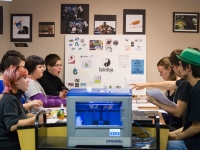Library Restorative Practices for Youth
Pima County Public Library, Ariz.
Innovation Synopsis
Within six months, the Library Restorative Practices for Youth pilot program reduced suspensions of minors by nearly 75 percent. The library trained staff, community partners and youth to co-create alternatives to traditional disciplinary actions. We developed a racially-diverse volunteer board that engages with youth and provides resources for growth and development.
Challenge/Opportunity
Despite differences in brain development, youth and adult behaviors were addressed using the same disciplinary guidelines; consequently, high-needs youth were disproportionately suspended. Our statistics reflected documented social and cultural inequities seen nationally, particularly with youth of color. Removing access to services did not align with our mission to embrace community, education and innovation. We saw an opportunity to build lasting community relationships and improve positive long-term outcomes with youth by developing a restorative model.
Key Elements of Innovation
Our process includes the following innovative elements:
- Creation of a culturally relevant board that reflects the community (ensuring linguistic representation) to meet with youth
- Development of materials that teach youth coping mechanisms, critical thinking skills and self-awareness about their behavior
- Reevaluate Code of Conduct consequences to align with youth developmental milestones and cognitive markers
- Train library staff on restorative justice practices, non-violent communication and social equity
- Expand innovative program to 26 libraries
Achieved Outcomes
We reduced suspensions and negative interactions with youth — some of our most vulnerable customers. Youth respond well when they participate in determining the consequences of their actions. We witnessed improved relationships among youth and staff, rewrote the accepted narrative about poor youth and youth of color and contributed to the greater possibility of creating lifelong library users. We recently hosted a PLA webinar that attracted 120 attendees, demonstrating national interest in restorative justice practices.

